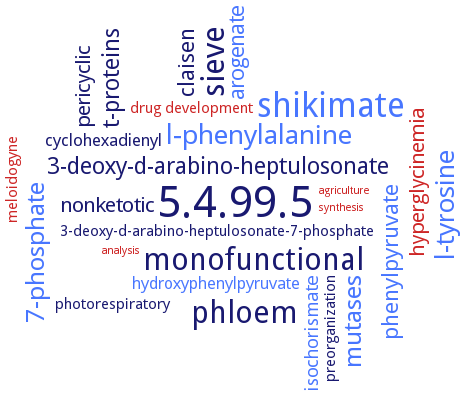5.4.99.5: chorismate mutase
This is an abbreviated version!
For detailed information about chorismate mutase, go to the full flat file.

Word Map on EC 5.4.99.5 
-
5.4.99.5
-
shikimate
-
sieve
-
monofunctional
-
phloem
-
l-phenylalanine
-
l-tyrosine
-
7-phosphate
-
mutases
-
t-proteins
-
3-deoxy-d-arabino-heptulosonate
-
phenylpyruvate
-
claisen
-
arogenate
-
pericyclic
-
nonketotic
-
hyperglycinemia
-
isochorismate
-
cyclohexadienyl
-
hydroxyphenylpyruvate
-
photorespiratory
-
preorganization
-
drug development
-
3-deoxy-d-arabino-heptulosonate-7-phosphate
-
meloidogyne
-
synthesis
-
agriculture
-
analysis
- 5.4.99.5
- shikimate
-
sieve
-
monofunctional
- phloem
- l-phenylalanine
- l-tyrosine
- 7-phosphate
- mutases
-
t-proteins
-
3-deoxy-d-arabino-heptulosonate
- phenylpyruvate
-
claisen
- arogenate
-
pericyclic
-
nonketotic
- hyperglycinemia
- isochorismate
-
cyclohexadienyl
- hydroxyphenylpyruvate
-
photorespiratory
-
preorganization
- drug development
-
3-deoxy-d-arabino-heptulosonate-7-phosphate
- meloidogyne
- synthesis
- agriculture
- analysis
Reaction
Synonyms
105-MtCM, 90-MtCM, AmtCM1, AmtCM2, aro7, AroA, AroH, AroQ, AtCM1, AtCM2, AtCM3, Bacillus subtilis chorismate mutase, Bphy_7813, BsAroH, BsCM, BsCM_2, BTH_I1596, chorismate mutase, chorismate mutase 1, chorismate mutase-prephenate dehydrogenase, Chorismate mutase/prephenate dehydratase, CM, CM type 2, CM-1, CM-prephenate dehydratase, CM-TyrAp, CM/PDT, CM/PDT/PDHG, CM0819, CM1, CM2, EcCM, EcCM-R, MI-CM-1, MI-CM-2, MjCM, MTB chorismate mutase, MTB CM, MtbCM, MtCM, Mutase, chorismate, Mycobacterium tuberculosis chorismate mutase, Mycobacterium tuberculosis H37Rv chorismate mutase, NC30, P protein, P-protein, PheA, PpCM1, PpCM2, Rv0948c, Rv1885c, SmCM, Tparo7, TtCM, y2828, YCM


 results (
results ( results (
results ( top
top






